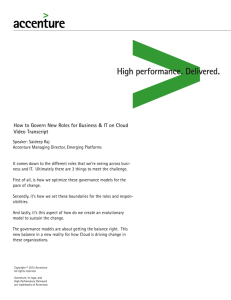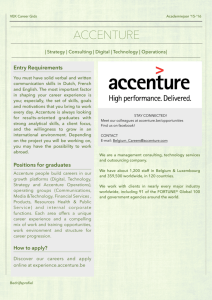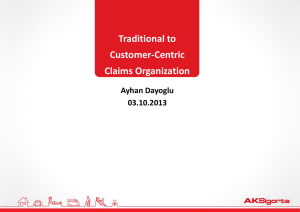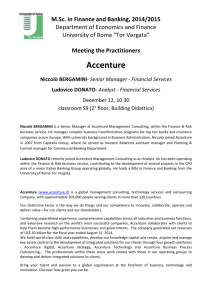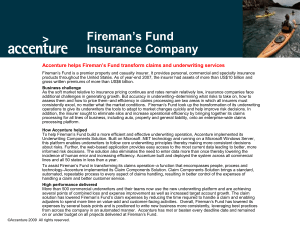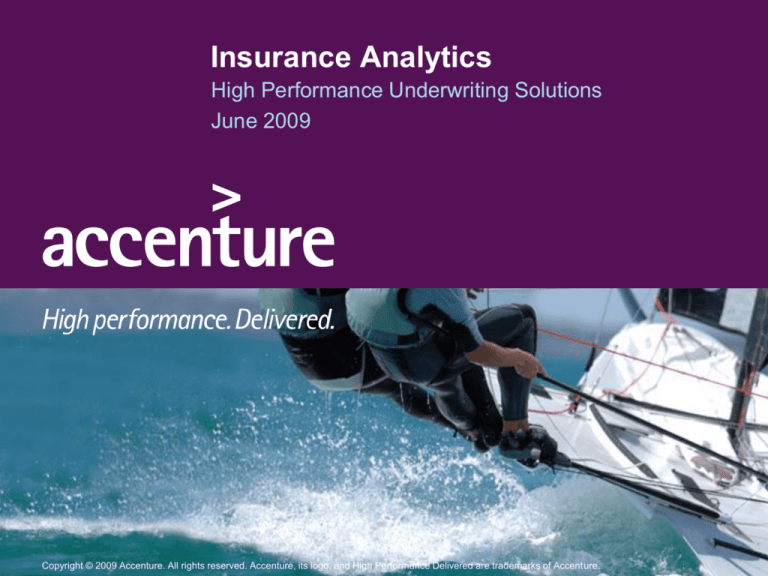
Insurance Analytics
High Performance Underwriting Solutions
June 2009
Copyright © 2009 Accenture. All rights reserved. Accenture, its logo, and High Performance Delivered are trademarks of Accenture.
Compelling Opportunity: Fiduciary
Necessity
While information is the primary currency of the business of insurance,
many insurers lack adequate insight to operate as high performers.
• Conventional business intelligence has grown out of a history of compliance reporting
requirements for regulatory bureaus and shareholders, and most MIS reflects this
• The legacy system environment and history of mergers & acquisitions inhibits data quality
and timely access
• Claim coding is not aligned with premium/policy coding conventions
• Inconsistent reporting standards globally forces complex reconciliation
• Exposure measurement tools (e.g., PML models) are confined to single line of business and
single peril thereby constraining insurers’ ability to develop integrated, enterprise views of
accumulation
• Operational technologies (e.g., task management, sales/submission management, call
center) are not yet broadly adopted thereby limiting insights into service metrics, sales &
submission outcomes, SLA compliance and individual service performance
• Third party data (e.g., peer benchmarking, industry loss experience, customer demographics)
is not readily integrated into the product development and actuarial processes to ensure
profitable alignment with growth expectations
Copyright © 2009 Accenture All Rights Reserved.
1
Strategic Importance of Business
Intelligence for Insurance
Timely data access and robust analytical capabilities provide
measurable, immediate value to the organization.
Loss Cost
Improvement
• Ability to more rapidly address pricing leakage issues or market leverage opportunities
• Ability to optimize capacity allocation in catastrophe exposure territories
• Improved insight into rating and pricing levers to optimize product filing strategies and underwriting
practices
• Better alignment between premium coding and claims coding to achieve more granular and
precise profitability insight
• Robust trending capabilities for improved loss development management
Expense
Savings
• More efficient and consistent data preparation facilitates data availability & reporting
• Dashboard, Reporting and What If Modeling tools empower business users
• Reduced exposure to regulatory fines due to incomplete or inaccurate data
Market share
Growth
• Improved product and geographic analytics enable more focused growth strategies
• Real-time insight into leading indicators of book movement , market penetration and cross-sell/up
sell to proactively manage growth drivers
Improved
Customer
Service
• Timely operational metrics to address service turnaround, SLAs and customer retention
• More granular distribution segmentation to optimize profitable customer segment growth
Copyright © 2009 Accenture All Rights Reserved.
2
Why Now?
Key Industry Trend
Implication for Insurance Analytics
Softening P&C
Market
• Increasing pressure to preserve rating and pricing adequacy
• Need to leverage micro-segmentation to find profitable market segments
• Growth will be fueled by differentiated products and services which are dependent on unique insights
Increased M&A
Activity
• Insurers must efficiently use vast amounts of disparate information from their acquired companies
• Core systems replacement driven by post-merger rationalization is bringing new front-end systems that
capture significantly more data about risk characteristics and claimant details
Advanced Pricing
Methods and Tools
• Pricing methods such as “Predictive Modeling” are being widely used in Personal and Small Commercial
Lines and are poised to be advanced through more sophisticated analytics
• Most large insurers are migrating to proprietary pricing models over purchasing third party model services
• External data is being increasingly leveraged to augment proprietary/internal data
Focus on Improved
Productivity
• Increasing need for consistency and efficiency in the core operations of Underwriting and Claims, as
highly skilled workforces age and retire, and exacerbated by M&A activity
• Growth imperatives are underpinned by cost optimization initiatives, thereby demanding greater capacity
within current resources
Changing Regulatory
Environment
• AM Best rating now includes a category for exposure accumulation practices
• Spitzer allegations have resulted in a push for increased transparency in broker / underwriter interaction
around the globe
• Sarbox regulations have implications for decision accountability and risk management practices
Copyright © 2009 Accenture All Rights Reserved.
3
Most insurers have focused their analytics
investments on reporting capabilities and
point-based predictive modeling.
Business Intelligence Maturity Curve
What’s the best that can
happen?
Optimization
Predictive Modeling
Forecasting/extrapolation
Competitive Statistical analysis
Advantage
What will happen next?
Analytics
What if these trends continue?
Why is this happening?
Alerts
Query/drill down
Ad hoc reports
Standard reports
What actions are needed?
Where exactly is the problem?
How many, how often, where?
Access and
Reporting
What happened?
Sophistication of Intelligence
Copyright © 2009 Accenture All Rights Reserved.
4
Competing on Analytics
Copyright © 2009 Accenture All Rights Reserved.
5
Accenture believes the most powerful
business intelligence is generated
through the integration of insights across
the insurance value chain
Insurance Value Chain Data Analytics Benefits
Enhanced Enterprise and Core Capability Decision Making
Product
Development
• Gain insights for
creating more tailored
products
• Improve ability to
deploy new products
effectively (filing
strategies, training,
marketing)
• Enhance primary and
secondary research
focus
• Leverage product
performance metrics to
improve business rules
and operational
efficiency
Marketing &
Distribution
• Identify potential
sales more precisely
by analyzing
customer purchasing
patterns
• Enhance agency
recruiting capabilities
• Optimize distribution
compensation
models
• Improve prediction of
product preferences
and customer
retention
Copyright © 2009 Accenture All Rights Reserved.
Pricing &
Underwriting
• Speed risk selection and
quoting with better
alignment between risk
quality and pricing
(reduced leakage)
• Provide timely insight into
price tiering models (eg.,
predictive models) to
adjust models for more
targeted marketing
• Identify non-core
underwriting operational
activities that are
candidates for automation,
elimination or delegation
• Improve utilization of
underwriting services
(premium audit, loss
control)
• Provide more accurate,
timely and detailed
understanding of exposure
accumulation
Policy
Processing
• Increase ability to
enhance servicing for
the most valuable
customers and
distributors
• Lower costs of
processing with
enhanced insight into
performance of
operational staffing
models
• Gain insight into
process bottlenecks
and detailed
transactions to
identify
improvements in
policy automation
Claims
• Improve timeliness and
accuracy of fraud
detection
• Enhance resource
allocation and
prioritization with better
insight and
predictability into claim
complexity and
settlement potential
• Improve subrogation
predictions
• Enhance reserving
practices
• Gain operational insight
to increase levels of
automation for simpler
claims
Performance
Management
• Improve consistency in
metric management for
the organization
• Improve alignment
between internal and
external data quality
and reporting
standards
• Achieve greater
granularity and
timeliness in reporting
for improved insight
and regulatory
compliance
• Increase user
sophistication in
performance analytics
through improved data
management and
analytic technologies
6
For Underwriting, sophisticated analytics
have become table stakes…
Product
Product Research
• Market Territory
Analysis
• Market Segment
Analysis
• Competitor Analysis
• Distributor Analysis
Product Design/
Performance
• Historical Product
Analysis
• Rate Making
Analysis
• Pricing Analysis
• UW Rule Analysis
• Loss Experience
Analysis
• Contract/ Forms
Analysis
Product Launch
• ROI Analysis
• Product Launch
Analysis
• Impact/ Disruption
Analysis
• What/If Analysis
• Regulatory/ Trend
Analysis
• DOI Relationship
Analysis
Marketing
• Market
Penetration
Analysis
• Strategic
Demographic
Analysis
• Competitor
Analysis
• Agency/
Distribution
Analysis and
Performance
Measurement
• Campaign
Effectiveness
(Affinity,
Advertising, Lead
Dissemination,
etc.)
• Account Rounding
Analysis
• Customer Value
Analysis
Sales
• Agent Performance/
Profitability Analysis
• NB & Quote Flow
• Hit and Yield
Analysis
• Cancellation
Analysis
• Retention Analysis
• in-Force Strategy
• Agent/Distribution
Performance
Analysis
• Channel/Access
Method Analysis
• Agency
Management
Analysis
• Sales Tool
Efficiency
• Acquisition Cost
Analysis
• Compensation
Analysis
• Relationship
Referral Analysis
• New Business
Sourcing Analysis
• Cross Sell / Up Sell
Analysis
• Lead Management
Copyright © 2009 Accenture All Rights Reserved.
Pricing/
Actuarial
• Pricing
Performance
including Tool
Usage
• Predictive Model
inputs/outputs/final
• Predictive Model
deviations from
Baseline
• Predictive Model
and UW Rule
Integrated Analysis
• Rate Adequacy
Analysis
• Marketplace
Analysis
• Profitability
Analysis
• Loss Ratio Analysis
• Loss Development
and Trending
• Rate Development
and Trending
• Residual Market
Loads (WC)
• Involuntary Book
Analysis
• Off-Balance
Analysis
• Reserve Analysis
• Expense Analysis
Underwriting
• UW Productivity
• UW Expense
Analysis
• SLA Mgmt
• Appetite Analysis
• Segmentation
Analysis
• Book Mix Analysis
• Hit and Yield
Analysis
• Referral Rates
• Authority Analysis
• Rule Analysis
• Price/Credit Analysis
• Agent Performance
by Account/Book
• UW Service
Utilization
• Market Comparison
Analysis
• Competitor Analysis
• Quality/Audit
Analysis
• Exposure
Management
• CAT Management
• Loss Experience
Analysis
• Reinsurance
Analysis (Treaty,
Fac)
Servicing
• Service Channel
Analysis &
Optimization
• Service Channel
Segmentation
• Knowledge
Management
• Content
Management
• Workflow Analysis
• SLA Mgmt
• Contact Mgmt
• Turnaround Times
• Cycle Times
• Straight-through
processing volume
• Escalation Analysis
• Reassignment
Analysis
• Customer
Complaint Analysis
• Policy Error
Analysis
• Span of Control
Analysis
• Self-service Inquiry
Analysis
Claims
• Claims
Assignment and
Routing
• Fraud Detection
• Formula Based
Reserving
• Reserve Analysis
• Claims Handling
Effectiveness
• Claims
Processing
Efficiency
• Subrogation
Analysis
Corporate
Performance
• Planning/
Budgeting
• Growth Analysis
• Book Mix and
Portfolio Analysis
• Profitability
Analysis
• Marketplace
Analysis
• Competitor
Analysis
• M&A Analysis
• Performance
Management
• Resource Attrition
• Investment
Analysis
• Expense Analysis
• ISO and Bureau
Reporting
• DOI/Statutory
Reporting
• Taxes, Boards &
Bureaus Analysis
• Voluntary
/Involuntary
Market Analysis
7
Accenture Insurance Analytics
Solutions: Predictive Modeling
Accenture's initial solutions for Insurance Analytics are focused on Predictive
Modeling to help clients leapfrog current approaches with impactful results in the
areas of Distribution, Underwriting and Claims.
Enhanced Enterprise and Core Capability Decision Making
Product
Development
Marketing &
Distribution
Pricing &
Underwriting
Distribution
Insight &
Optimization
Pricing
Insight &
Optimization
Policy
Processing
Claims
Performance
Management
Predictive
Claims
Processing
Common Deployment Solution
Copyright © 2009 Accenture All Rights Reserved.
8
“Generation 1” Predictive Models have
enabled more precise product pricing at
most insurers…
“Now, we've actually got predictive modeling tools that allow us to improve the overall quality of our
underwriting decisions and improve the consistency of what we're doing from underwriting our book.“
JAMES LEWIS, PRESIDENT AND CEO, CNA PROPERTY & CASUALTY OPERATIONS
“Our models categorize the best risks as five diamonds and the worst as one diamond. Early indications
for BOP are that loss ratios for five-diamond accounts are three times better than those of one-diamond
accounts, and we're writing significantly less of the one-diamond business.“
DALE THATCHER, EVP, CFO, SELECTIVE INS. GROUP, INC.
“It's a data-base industry now, particularly in small face-value kind of business, and so we are very focused on
innovation around product, particularly things like predictive modeling.”
FRED EPPINGER, CEO, THE HANOVER INSURANCE GROUP, INC
“We started with automated underwriting platform or multivariate predictive models with commercial business
three - four years ago. Today we have over 80% of our business on an automated underwriting platform.
We think we're one of the strongest underwriters in using predictive models here.”
MIKE HUGHES, EVP - INSURANCE OPERATIONS, SAFECO CORPORATION
Copyright © 2009 Accenture All Rights Reserved.
9
…But additional capabilities are needed
to advance Predictive Modeling along
the Maturity Curve for increased and
durable benefits
WAVE I
Corporate Mission
and Objectives
Off-Line Model
Process Foundation
• Scaleable technology
• Management process
• Quality controls
• Transparency
• Internal competency
WAVE II
WAVE III
Basic Integration
Robust Integration
Process Mastery
• Enterprise scope and scale
• Process and resource
stability and alignment
• Payback on technology
investment
Process Optimization
Proprietary models
Enriched external data
sourcing
Robust solution integration
Automated and integrated
model and rule testing
Automated model/rule
deployment
Externalized model/rule
maintenance by business
Market cycle tolerance
•
•
• Management and
leadership maturity
•
•
• Quality maturity
• Create “Speed to Market’
(reduce analytics cycle
time)
• Create reusable process
• Build credentialed
and technology
resource pool across
the enterprise
•
•
•
• Expand Model scope
and scale
• Add LOB’s under model
• Establish Internal
competence
• Grow % of premium/
claims under model
• Establish scaleable • Complete reference
models
• Invest in Modeling model deployment
Pro forma
architecture
technology and
resources
Metrics
Re baseline
Metrics
Baseline
NEAR TERM
Copyright © 2009 Accenture All Rights Reserved.
MEDIUM TERM
LONG TERM
10
Generation 1 Predictive Model
Challenges
• Use of external model vs. proprietary development
(dependency on industry results, lack of model
transparency)
• LOB vs. Account/Customer model orientation
• Lack of model granularity: location, agent/broker,
• Lack of model integration with other rules (underwriting,
rating, forms)
• Lack of integrated book of business testing facility and
“what if” scenario model impact analysis tools
• Lack of externalized model rule management
capabilities in the hands of the business
• Lack of automated deployment/release management
• Limited performance insight across models and other
rules
Copyright © 2009 Accenture All Rights Reserved.
11
Accenture’s UW Predictive Model
Solution enhances business benefits
through effective lifecycle integration
Accenture Underwriting Modeling Solutions
Source Data
3rd Party
Integration Services
Data
Services
Claims
ETL
Data
Cleansing
Data Matching
Data Profiling
Data Quality
Data
Integration
Data
Augmentation
Policy
Sample
Data Sets
DW
Product
Palette
Testing
Interfaces
Production
Impact
Analysis
Trial
Rates
Rating
Engine
Displacement
Trial
Rules
Rules
Engine
Rules
Impact
Trial
Models
Scoring
Engine
Tier/Score
Impact
Copyright © 2009 Accenture All Rights Reserved.
Rules
Application
Rating
Application
Production
Rates
Premium
Production
Rules
Production
Models
Monitored Data
Development Applications
Model
Application
(Transaction
Systems)
Score /
Tier
Mods /
Factors
Rules
Fired
12
This end-to-end UW Predictive Model
Solution brings additional cost and growth
benefits not achieved with Generation 1
solutions.
Benefit Drivers:
• High percentage of underwriting decisions
untouched (manual underwriting on an exception basis only)
• Reduction of data acquisition costs
• Reduction of administration and selling expenses
on a per policy basis
• UW & Pricing changes quickly brought to market
• Timely cross selling of products
• Positively influence channel production by
improving the carrier/channel interface (easy to work
Expense
Reduction
(5-15%)
Premium
Growth
(varies by
strategy)
with)
• Proactive targeting for new business
• Targeted renewal pricing and improved retention
• Consistent, error-free selection of individual risks
• Alignment of risk selection and existing book of
business with overall risk profile objective
• Proactive management of non-renewals
• Risk selection improved through the identification
and qualification of relevant predictors of loss
Loss Ratio
Reduction
(4-5 pts)
Offline
Model
Basic
Integration
Copyright © 2009 Accenture All Rights Reserved.
Robust
Integration
* Benefits are further enhanced as predictive modeling is
integrated into other business functions
13
Accenture’s solution enables insurers to
industrialize their predictive modeling
capabilities throughout the organization.
Model
Development
Objectives:
–
–
Identify data
attributes that are
predictive of the
outcome being
measured (e.g., Loss)
Derive the most
reliable algorithm to
calculate a predictive
score, based on
extensive analysis of
historical data
Model
Integration
Objectives:
–
–
–
–
Copyright © 2009 Accenture All Rights Reserved.
Integrate predictive
scores into business
processing via rules
engine configuration and
portal/UW/Policy system
integration
Develop business rules
to provide further
guidance & explanation
of the scores
Test impact of models on
book of business and
with other rules
Deploy models/rules into
run-time environment
Model Refinement
& Extension
Objectives:
–
–
–
Establish timely
operational data
extracts for real-time
performance insights
Establish flexible
platform that
externalizes model/rule
maintenance to rapidly
change rules,
explanations, and
predictive scores
Extend predictive score
information into broader
areas (servicing, sales)
14
Accenture Enables Speed to Integrate New
Models
Results with Accenture
Common Challenges
• Flexible Scoring Engine requires minimal or no
new development to adapt to new model
structures
• 2 – 6 months lead time to integrate new model
structures
• Scoring Engine not flexible enough to adapt to
new model structures
• 9 – 18 months lead time to integrate new model
structures
???
GO
Accenture’s Differentiated Answers
Rules-based scoring engine
Robust model deployment architecture
Configurable Scoring Process Architecture
Accenture Assets:
New Predictive Model
Scoring Specifications
Scoring Rules Management
Rules
Exceptions?
Author
Migrate
Test
Analyze
Scoring Engine
Wrapper (SOA)
Rules Engine
(Blaze,iLOG)
Yes
Process
Rules & Process
Copyright © 2009 Accenture All Rights Reserved.
Author
Migrate
Test
Analyze
• Onshore & Offshore Blaze
Advisor & iLOG Scoring &
Rules Engine
Implementation Skills
• Blaze & iLOG Scoring
Engine Software
Accelerators
Scoring Process Configuration
No
• Solution Approach Options
& Reference Architectures
Automated Model
Deployment Utilities
• Model Deployment Utilities
• SOA Scoring Engine
Wrapper Software
Accelerators
15
Accenture Enables Efficient Use of 3rd Party
Data
Results with Accenture
Common Challenges
• 3rd Party Data not cleanly matched to internal
data
• Data refresh, scrubbing, matching, storage, and
utilization options difficult to navigate
???
• Cohesive data integration & utilization
• Automated matching with configurable
accuracy/exception thresholds
• Thoughtful, guided decisions on all key points of
consideration
GO
Accenture’s Differentiated Answers
Integrated (real-time and batch) 3rd Party Data
T
Thresholds
3rd Party
Extensions
3rd Party Data Integration
Data Utilization
3rd Party
Overlay
3rd Party
Extensions
3rd Party
Overlay
Internal
Data
Internal
Data
Cohesive data utilization
Accenture Assets:
Customer
Policy
Sophisticated data matching
T
Data Matching
T Data Matching
T Data Matching
Data Matching
T Data Matching
T Data Matching
Copyright © 2009 Accenture All Rights Reserved.
Real-Time Interface
Real-Time Interface
Real-Time Interface
3rd Party Data
Source
A Data
3rd Party
Source
A Data
3rd Party
Source A
Batch Interface
Batch Interface
Batch Interface
3rd Party
Source F
• Data integration / utilization
options & best practices
3rd Party
Source E
• Proprietary Data Matching
Software Accelerators
3rd Party
Source D
• Onshore & Offshore 3rd Party
Data integration Skills
3rd Party
Source C
• Third Party Data Service
Provider Alliances
3rd Party
Source B
3rd Party
Source A
16
Accenture Enables Effectiveness of
Business Rules
Common Challenges
•
•
•
•
Results with Accenture
• Clear, timely & consistent rule requirements
• Flexible & effective rules architecture established
quickly
• Rules consistently managed to the highest quality
throughout their lifecycle
Rule requirements difficult to crystallize
Rules architecture not well defined
Rules quality/completeness not validated
Rating & UW rules not well aligned to leverage
Predictive Model Scoring
???
GO
Accenture’s Differentiated Answers
Proven rule requirements process & templates
Rule Properties
Explanation Text
Rule Name
Rule
Description
Rule Type
Rule Type
Conditions Needed
Line Of Business is <select a LOB>
Program is <select a Program>
State <select a State>
Market Indicator <select a Market Indicator>
Effective Date is between <start date> and <end date>
Transaction Type is <select a Tranasaction Type>
Description/Definition
Business Area
Identification ID Source
this rule is in scope
Date
All input record attributes (no scoping conditions)
difference in days between <start date> and <end date> <operator> <value>
difference in months between <start date> and <end date> <operator> <value>
Derivation
difference in years between <start date> and <end date> <operator> <value>
difference in days between <start date> and today <operator> <value>
The rules that govern the process of updating and maintaining the
difference in months between <start date> and today <operator> <value>
agent hierarchies.
difference
in years
between
<start date> and today <operator> <value>
The rules that govern the processing
of background
checks
for
producers such as when to order,
and, ultimately,
thisordering
rule isfequency
in scope
approval or denial.
All input
record
attributes
(no scoping conditions)
The rules that are used to facilitate
effective
management
of agent
education requirements.
count of <derivations> within <timeframe> days <operator> <value>
The rules that govern the process
of developing
a contract between
count
of <derivations>
within <timeframe> months <operator> <value>
internal employees and agents, as well as the rules for managing
of <derivations>
within <timeframe> years <operator> <value>
agent/producer licenses (new, count
maintenance,
verification). This
includes interaction with state bureaus
and<derivations>
any subsequent <operator> <value>
count of
Knock-Out
obligations.
In addition, Contracting
includesin
thedays
contracted
base <start date> and <end date> <operator> <value>
difference
between
commissions.
difference
months
between
<start date> and <end date> <operator> <value>
The rules that are used to determine
the validinproducer
code
and
sub-codes that are used by thedifference
various systems.
This isbetween
specific to <start date> and <end date> <operator> <value>
in years
setting up a new producer in the
system.
difference
in days between <start date> and today <operator> <value>
The rules that govern the types of risks and products that can be
difference
in months
<start date> and today <operator> <value>
written for a particular agent. This
can be regulated
by the between
type of
producer, state, type of risk, authority
level, etc.
This includes
both <start date> and today <operator> <value>
difference
in years
between
Scoping
General Info
Category
Rule
Taxonomy
Sub-Category
Agency/Producer
Management
Agency Organization
Agency/Producer
Management
Agency/Producer
Management
Background Checks
Education
Management
Agency/Producer
Management
Licensing and
Contracting Rules
Agency/Producer
Management
Producer Code and
Sub-Code Rules
Agency/Producer
Management
Agency/Producer
Management
Alliance Relationship
Management
Billing & Collections
Billing & Collections
Billing & Collections
Billing & Collections
Billing & Collections
Billing & Collections
Claims
Claims
Rule Architecture
Requirements
contractual and license eligibility. This also pertains to subProducer Eligibility
producers.
Writing Company
The rules that are applied to determine the ultimate writing company
Appointment
to which an agent will be assigned.
Ability to manage relationships with third party providers of products
and services (e.g. TPA's, Affinity Groups, Specialty Products
Carriers)
Rules that determine the handling for the collection of bad debts (inBad Debt Collections house vs. 3rd Party).
Billing and
Cancellation
Timeframe and
The rules that govern the timeframes of notifications of policy bills
Notice Rules
and pending cancellations.
Billing Options
Rules that determine the valid billing options (monthly, quarterly,
Eligibility
annually).
Billing Schedule
The rules that govern the amounts to be billed based upon effective
Rules
date and current date of the policy.
Rules that regulate the billing type options that are available for a
Billing Type Eligibility risk (e.g. direct bill or agency bill or 3rd party bill)
Payment Method
The rules that determine the valid methods for payment (e.g. EFT,
Eligibility
Credit Card, Cash, Check)
The rules that regulate the process of capturing first notice of loss
Claim Notification
information.
The rules that determine the routing of a claim to a particular system
Claim Routing
and assignment to a team.
Copyright © 2009 Accenture All Rights Reserved.
Rule Flow
Model
Rule Methods
Condition In
Condition
Drop-Down (Y/N) Frozen (Y/N)
Y
N
Y
N
Y
N
Y
N
Y
N
Y
N
Sample
N
Y
Y
N
Y
N
Y
N
Y
N
Y
N
Y
N
Y
N
N
Y
Y
N
Y
N
Y
N
Y
N
Y
N
Y
N
Y
N
Y
N
Y
N
Y
N
Y
N
BR Education
& Change Mgt.
Actions Needed
<select a rule>
Rule
Constructs
Meta-Data
Approach
Applicability
Approach
Business Rule
Rule Methods
Versioning
OrganizationMeta-Data
Meta-Data
Approach
Approach Approach
BR
Technology
Director
BRCC
Partnership
set result code to DELINE
Director
set result explanation to <enter explanation>
Product Mgt.
BR Standards/
Operations
BR
Management
Marketing
Reference
Data Approach
Rule
Decisioning
Technology
Technology
Rule
Deployment
Project Management
BTI
SME(s)
to guide key BR
Competency
Partnership
Technology
decisions &
Leader
content:
- Rule tech. solution design
- RuleBRCC
tech. vendor selection
Partnership
- Rule
perf. optimization
Director
- Rules
tech. stewardship
BRCoE will
provide
a point of
Rule Management
Software Workstream
IT
Account Exec
Rule Development
Workstream
Claims
Etc.
Key interaction
Rule Migration
Integrated
Rule Testing
Rule Impact
Analysis
Migration Grouping
Rule Query
Test Data Maintenance
Migration Scheduling
Rule Status Mgmt
Test Population Maintenance
Deployment Triggering
Rule Locking
Test Case Maintenance
Enterprise
Repository
Rule Archiving
Test Case Execution
Concurrent Editing
Test Results Analysis
Rule History & Audit
Rule Test Environment
Software Testing
QA Rulebase
SW Test
Environments
SW Testing
Best Practices
Type-Specific
Repositories
Rule Management
Portal
Management Information
Production Rule
Results Analysis
Rule Repository
Views & Analysis
Research Rule
Results Analysis
Data Warehouse
Integration
Rule Harvesting
BR
Product & UW
SMEs
Rule
Librarian
Accenture Assets:
• Innovative rules
architecture point of view
• Industry leading rules
management framework
• Rule requirements
templates & best practices
• Onshore rule requirements
gathering skills
Rule Harvesting
Rule
Requirements
Business Areas
Business
Growth
Business Vision
Source & topic of interaction
Rule Domains
Rule Testing
Rule Unit
Testing
Rule Copy
Technology
Object Model
Director
Rule Execution
The
coordination
across rule domains & business
Change areas to:
Harvesting
BR Technology
Software
Workstream
• Develop & allocate the staffing to implementArchitect
& manage businessDependencies
rules
Methodology
Rules Solution
• Build awareness & expertise to guide business
rules capability development & utilization
Architecture
Application
Infrastructure
• Facilitate
collaboration in key business rules activities & decisions
Management
Management
• Promote consistency in business rules best practices
BR
Architect
Rule
Rules
Externalization
Architecture
BR
BR
Opportunities
Manages the allocation of pool
Manages the
Coordinates BR
Training / change
Methods and tool
BR
BR
management
resources to augment projectBR Education
allocationBR
of Standards/
pool
infrastructureBR
runtime
specialist to manage:
Application Rule Architecture
Infrastructure
IT (SOA)
&
Management
& Change Mgt.
Rule Project
specialist to manage:
staffing:
resources Operations
to
operations,
Management Rule Technology
Management
- Methods, tools,
Methodology
Architecture
augment project
configuration, and Rule
- Business rules analysts
Rule
- Skill assessments
and knowledge
staffing:
deployment Requirements
Results
(rule requirements, design
management
Business Rules
- BR education and
Rule Taxonomy &
support, development,
- Rules software (upgrades)
Competency Center
training
Domain Mapping
- Performance
• Rule Stewardship
testing, migration, and
and integration
Metrics/ Rpts.
• Rule Standards
- Mentoring and
maintenance)
developers
Business
• Rule Policies
OTJ training
- Process
Business Rules Mgmt. Teams • Rule Education
Value
- Verification & validation of
improvement
- Team building
specialtiesBusiness Areas /
Product
Work
Rule Externalization
• Rule Results Ownership
Config.
Mgmt.
Business
- Administrative
Commercial Markets
- BR career path
Opportunities
Decision
Sponsors
Underwriting
Product
Mgt.
Marketing
Etc.
- WorkshopInitiative
facilitators
Support
support
- Skill database
• Strategic Planning Small Business
• Prioritization
• Investment
Opportunities
Rule Authoring
Repository
Architecture
Rule Operating Model
Y
Y
BR Technology
Architect
Other
Organization
Organization
Approach
Approach
Rule Execution
Rule Outcome
Systems Comment
RuleSystem(s)
Consuming
Rule Service
Rule Service
System(s)
Technology Security
Integration
Partitioning
Performance
BR
Architect
SME(s) to guide
key BR
Governance
Investment
decisions & content:
Confirmation
Business
IT
- Rule logic &
approach
design Architecture
Council
- Rule capability
requirements
Claims
- Rule taxonomy &
domain mapping
Underwriting
- Rules stewardship
Applicability
Approach
Rule
Management
System(s)
IT
Account Exec
Partnership
Rule Management Suite
Business
Versioning
Technical Architecture
Systems
Reference Y
Data ApproachN
Sample Outcomes
record this derivation
set date of occurrence to <date>
BTI
Competency
Leader
Rule
Constructs
Constructs
Action
Frozen (Y/N)
N
Rule Flow
Model
Etc.
Actions
Document Generation
…
Decision Support
State
Data Extension & Validation
Transaction
Work Management
Coverage
Rule Architecture
Rule Mgmt.
Conditions
Rule ID Product
Rate Determination
Rules
Product Configuration
Rule Specification
Comprehensive rules management framework
Robust rules architecture
Business
Profitability
Commercial
Specialty
Personal
Business Areas
Claims, Product Management, Underwrite Risk
© 2007 Accenture. All rights reserved.
17
Accenture Enables Adoption of Business
Change
Common Challenges
Results with Accenture
• Business process & organization changes not
aligned with either the model design or integration,
and are difficult to agree upon
• Timely and appropriate communications & training
are lacking
• Business changes clearly aligned with both model
design and integration via structured collaboration
throughout implementation
• Leadership & key stakeholders are informed &
aligned from early on
???
GO
Accenture’s Differentiated Answers
Communication Plan
Broad communications plan developed and
vetted early with key stakeholders
Plan & Analyze
Actuarial
Product Mgrs.
Field UW
Home Office
Accenture
IT, etc.
Design
Process
Design
Org.
Design
Training &
Performance
Mgmt.
Copyright © 2009 Accenture All Rights Reserved.
Process & organization changes, training and performance
management developed collaboratively to align with industry
best practices and unique solution aspects
Build
Test
Deploy
Accenture Assets:
Structured Collaboration
• Industry leading Training &
Performance Management
Practice
Industry Best Practices
• Process & organizational
change reference models
Unique Solution Considerations
• Communication plan
reference models
18
Accenture has a track record of successful
solution implementation with predictive
modeling
Keys to Effective Predictive Modeling Solutions
Clear Vision
Thoughtful Design
Coordinated Delivery
Increased Process
Automation
Flexible, RulesBased Solution
Clearly Defined RollOut Strategy
Selective Integration
Points
Scalable SOA
Framework
Cross-Organization
Dependency Mgmt.
Frequency and
Severity-Based Models
Integrated Internal &
3rd Party Data
Cross-Organization
Training
Analytics-Directed
Appetite
Robust Management
Information
Leadership Backing &
Communications Plan
Proactive Underwriting
Process Changes
Model Change BetaTesting Platform
Calculated Offshore
Delivery Model
Coordinated Business
Rules Management
Model Development
Platform
Parallel Development
& Testing Tracks
Copyright © 2009 Accenture All Rights Reserved.
19
Getting Started:
Proof of Value
Accenture would work with you to conduct a short project to determine solution approach
options and define potential scope and business value for the integrated solution.
Accenture Responsibility
• Proof of Value Business Case: Develop the
business case, capability scope, and high level
business and technical requirements
– Technical Architecture Assessment
– Data Services Survey
– Vendor Services analysis
• Conceptual Design – pro forma design
documents to integrate current or updated
predictive models with production systems and
testing/analytics solutions
Copyright © 2009 Accenture All Rights Reserved.
Client Responsibility
• Part time support (25% - 50%) from
cross-functional team of IT, selected
business/functional areas, analytics
group and stakeholders
• Weekly status meetings with key
stakeholders to evaluate deliverables and
provide direction.
• Provide current and planned application
architecture documentation
• Provide current and planned data
services and model deployment
architecture
20
Proof of Value Approach
Weeks 1-2
Base Case
• Evaluate current predictive models,
Model Development modeling capabilities and model update
cycle
Integrated
Architecture and
Data
Organizational
Readiness
• Define business case for Proof of Value
• Define conceptual Design for Integrated
Solution
Weeks 3-5+
• NA
• Develop Proof of Value – basic functionality
for integrating rates, rules, and predictive
models in a test environment
• Develop Proof of Value – basic functionality
for better integration of predictive models with
rules engine in a test environment
• Assess Analytics Management Processes
• NA
and Resources
Copyright © 2009 Accenture All Rights Reserved.
21
Sample Accenture Credentials
•
Large National
Insurance
Company
•
•
Integrated financial data across disparate acquired companies to reduce financial close,
consolidation and management reporting times as well as eliminate manual processes.
Defined a global management reporting process and developed the EDW solution
Developing Center of Excellence for Analytics & Modeling
•
•
•
Specialty Lines predictive model configuration and integration to fuel lower touch growth model
Integrated with policy system and FairIsaac/Blaze rules engine (including other UW rules)
Provides guidance messages
•
Commercial lines Business Intelligence solution, including data warehouse, product/pricing
analytics (SAP/BO) for BOP, Auto, WC, predictive model analytics, operational analytics
Enterprise Finance Data Mart
Developed forecasting/planning desktop (MSFT BI)
•
•
•
•
•
•
•
Enterprise Data Services including Master Data Management strategy/implementation
•
•
Data Warehouse implementation including ETL, data prep, and analytical tools
Product Development solution leveraging best of breed components, including Blaze Advisor
for underwriting and pricing rules and Skywire Insbridge for rating
Data Warehouse/Analytics
Enablement of STP for Commercial Lines
Installation of Accenture Underwriting and Claims assets
Implementation of new Policy system for Personal Lines
Copyright © 2009 Accenture All Rights Reserved.
22
APPENDIX
Copyright © 2009 Accenture All Rights Reserved.
23
Insurance Analytics
Capability Blueprint
Users
UW / Product
Claims
Producer /
Cust. / Vendor
Actuary
Sales /
Service
Executive
Data Access
Drill Down
Standardized
Export
(Excel / Access)
Real Time
Batch
Ad-hoc
Side-by-Side
User Tailored
GIS / Mapping
Authority /
Security
Enabling Capabilities
Simulation
Testing
Report Generation
Scheduling
Alerts / Notifications
KPI’s
Trending
Common Data
Definitions
Forecasting
Analytics
Data Enrichment
(3rd Party)
Executive
Info
UW / Prod / Claims
Decision Support
Sales / Mkt
Decision Support
Actuarial Info
Management
CAT / Exposure
GIS
Modeling
Information Refinement
Data Layer
Data Marts
Data Warehouse
Interfacing Source Systems
Claims
Financials
Copyright © 2009 Accenture All Rights Reserved.
Legacy
Policy
External /
3rd Party
Distribution
Mgmt
24
Insurance Analytics
Technology Blueprint
Our solutions are supported by a target technology architecture that enables speed of predictive solution
implementation while positioning the insurer with a strategic infrastructure for enterprise analytics.
Staging
Sources
Data Warehouse
Operational Data Store
Reporting & Analytics
Analytical Data Sources
Marketing
Analytical
Data Model
Repository
External Data
Operational Data
Store (ODS)
ETL
Core Transaction
Applications/Data
Data
Dashboards
Subject Area Data Marts & Cubes
Producer
Underwriting
Unstructured
information
landing
area
Claims
Data
Warehouse
Master Data
Repository
(Producer,
Product, Policy,
Customer,
Location)
Reporting
Operations
Score/ Rules
Engine
Underwriters
Data Miner
Model Mgt &
Applications
Business
Claims
Mgt
Product
Managers
Dimensional Views
Policy
Data Archive
Match
Merge
Data Quality
Business
Metadata Management
Copyright © 2009 Accenture All Rights Reserved.
Actuaries
ETL
Repository
Extract, Transform, Load (ETL)
Standardize
Data
Miners
ETL
Proprietary &
Public
Monitor
Audit
Technical
Balance
Control
Metadata
Dictionary &
Repository
25
Accenture’s Insurance Analytics Offering:
Pre-Built Architecture Assets
PHASES/
WORKSTREAMS
Model
Development
Integrated
Architecture
and Data
Organizational
Readiness
Plan
Analyze
Design
Build
Test
Deploy
Maintain
• Model Design Specification – reusable pro forma model designs based on known problem statements (e.g. fraud)
• Meta Data Dictionary – A reference data specification specific to a model type (e.g. subrogation) that identifies the individual data
attributes to be used in Sample Set development
• ‘Raw Data’ ETL Procedures to populate the model development sample set from the transaction data
• ‘Raw Data’ data pre-processing routines to populate the model development sample set
• Derived Predictors – highly predictive features created from raw data inputs, applicable to all sample data sets for a common problem
statement
• Insight Visualizations – typical visualizations for unsupervised/exploratory models that provide insights into unexpected patterns and
data clusters
• Data Quality Reporting Templates – reusable reporting and metrics for data quality relative to usable features for modeling
• Validation Reporting Templates – reusable report template for validating predictive models (validation approach)
• ‘Raw Data’ ETL Procedures to execute the model algorithm at prediction time with live transaction systems data
• ‘Raw Data’ data pre-processing routines to execute the model algorithm at prediction time with live transaction systems data
• Data Services (interfaces) – ACS interfaces to third party data (run-time model execution)
• Pre-loaded 3rd Party Data Sources – preloaded tables for external data sources (free public data relevant to Model Design
Specifications)
• Pre-designed 3rd Party Data Interfaces – common external data interfaces to proprietary data that is typically used to improve the
prediction accuracy of models
• Advanced Model Maintenance Architecture – interface and functionality to dynamically improve models from the transaction data flow
• Report Designs – business relevant report designs typical for management user needs
• User Interface Designs – sample user interfaces presenting a likely deployment of model output to the user in the transaction system
• Rule Designs – typical business rules to interpret and act on prediction outcomes for a model type
• Deployment Strategies,
• Change Management Approaches
Copyright © 2009 Accenture All Rights Reserved.
26
Accenture’s Insurance Analytics Offering:
High Value Capabilities and Accelerators
Our capabilities and accelerators can reduce the cost and risk of implementing
predictive models and analytics across the enterprise for underwriting, claims and
distribution operations.
•
Methodology and Tools to accelerate the design, development and deployment of the analytical
models
•
Experienced Insurance Analytics and Actuarial services to develop, extend, and enhance the
new analytical models
•
Market leading analytics software suite to develop and maintain analytical models
•
Technology expertise to install, configure, and integrate modeling software into the insurer’s current
application environment
•
Integration architecture to integrate Accenture’s Insurance assets (ICC, CCS, UWC) with the
analytics software suite
•
Robust metadata dictionary based on logical and physical insurance data models to rapidly define
required data
•
Data services to automate the connection to 3rd party data
•
Business solutions that address today’s business problems and also representative of predictive
modeling capabilities that can be applied broadly across the enterprise
Copyright © 2009 Accenture All Rights Reserved.
27
Integrating analytics into the
enterprise requires clear
organizational accountability and
responsibility.
Centralized/Enterprise Services
ILLUSTRATIVE
Enterprise Analytics
Scope
•
•
•
•
•
Methods/Standards
Strategy
Requirements
Build
Deploy
Market and
Competitor
Intelligence
Customer
Insight &
Experience
Exposure
Accumulation
Intelligence
Distribution
Insight
Process
Improvement
Analytics
Analytics Technology and Data Governance
Financial Support
Line of Business/ Functional Representation and Demand Management
Personal
Insurance
Analytics
Decentralized/Line of
Business Focused
Business
Insurance
Analytics
Corporate
Analytics
Scope:
•
•
•
•
Strategy
Requirements
Prioritization
Assigning Resources
Lines of Business / Functional Leadership
Scope
• Line of Business and
Functional Reporting and
Analysis
• Operationalize analytics
Competency
Centers (Others
TBD)
Product
Modeling
Copyright © 2009 Accenture All Rights Reserved.
Claims and
Service
Analytics
UW and
Pricing
Functional
Analytics
(HR, Mrktg,
Fin)
28
Data – Current and New
Data Type
Claims
Client
% of Accounts Buying Risk Services
Average Claim Amount by Loss Type
Average Property Rate by Client Size
Client Loss Ratio
Co-Brokerage Allocation
Coverages Purchased by Client Size
Annual Sales
Insurer Services
Compensation Type
Form Type
Head Count
History
LOBs brokered by Insurer
# Locations
Operational Detail
SIC
TIV
Acquisitions
Average Time to Payment
Carrier Services
Growth/Expansion Plans
Quota Share/Excess
Copyright © 2009 Accenture All Rights Reserved.
Data Source
Insurer
Insurer
Insurer
Insurer
Insurer
Insurer
3rd Party
Insurer
Insurer
Insurer
3rd Party
Insurer
Insurer
3rd Party
Carrier
3rd Party
Carrier
3rd Party
Insurer
Carrier
3rd Party
Insurer
Current
New
Current
New
29
Data -- Current and New
Data Type
Carrier
Location
Key Individual
Loss Control Services Offered
Policy Error Rate
Policy Issue SLA
Product Profile
Quoted to Bound
Rating, Pricing Detail
Submitted to Quoted
% Sprinklered
Construction Type
Earthquake Zone
Flood Zone
Location (Lat/Long)
Occupancy Type
Alarm Coverage
Alarm Types
Distance to Fault
Distance to Next Aon Client Location
Distance to Water
EQ PML
Flood PML
ISO Town Class
Slope, Aspect, Gradient
Total Lifetime Losses
Copyright © 2009 Accenture All Rights Reserved.
Data Source
Carrier
Carrier
Insurer
Insurer
Insurer
Insurer
Carrier
Insurer
3rd Party
3rd Party
3rd Party
3rd Party
3rd Party
3rd Party
Client
Client
3rd Party
3rd Party
3rd Party
3rd Party
3rd Party
3rd Party
3rd Party
3rd Party
Current
New
Current
New
30
Integration and modeling of this enriched data
will enable enhanced statistical analysis and
forecasting.
Location
Carrier
Client
Claims
Benchmark/Trend
Copyright © 2009 Accenture All Rights Reserved.
% of Accounts Buying Risk Services
Average Claim Amount by Loss Type
Average Property Rate by Client Size
Client Loss Ratio
Co-Brokerage Allocation
Coverages Purchased by Client Size
Deductibles by Coverage
Fee-vs-Bundled Service by Service Type by Client Size
Limits Purchased
LOBs Purchased by Client Size
Total Lifetime Revenue per Account
% of Locations Buying NFIP Coverage
Commission vs. Fee by Client Type by Geography
Location Propensity for CAT Claims by Client Type
Account Revenue per FTE
Average Cost of Acquisition
Average Cost to Remarket
Average Cost to Renew
Cancellations/Reinstatement Trends
Cost to Convert
Cost to Service
Frequency and Severity $$ by Loss Type by SIC
FTE Productivity (Leverage Ratio)
Lead Generation Metrics
Net Price by Product by Client Size
New Business/Renewal Hit Ratios by SIC by Carrier
Payment Trends
Premium Change (exposure/rate/price)
Prospecting/Sales Metrics
Prospects to Accounts by Carrier by Office
Service Effectiveness
# & Type Transactions per Account by Size
Source
Insurer
Insurer
Insurer
Insurer
Insurer
Insurer
Insurer
Insurer
Insurer
Insurer
Insurer
Insurer
Insurer
Insurer
Insurer
Insurer
Insurer
Insurer
Insurer
Insurer
Insurer
Insurer
Insurer
Insurer
Insurer
Insurer
Insurer
Insurer
Insurer
Insurer
Insurer
Insurer
Current
New
31
More predictive and optimized analytics
will position the insurer to create “game
changing” innovations to grow its
business.
• New Product & Service Offerings
• Enhanced Client Performance
• Diversified Revenues
• Increased Market Leverage
• Optimized Delivery Platforms
Copyright © 2009 Accenture All Rights Reserved.
32
Big Ideas
Differentiated Program Offering
• Target SICs, geographies, size
• Tailored coverage forms
• Proprietary rating/pricing methodology
• Streamlined application process
• Affinity/sponsor organization exclusive
membership access
• Special risk engineering services
• Business Income consultative
services (fee-based, sourced through
accounting firm network)
• Preferred market arrangements with
carriers, including pre-negotiated
servicing terms
• Proprietary risk scoring tool to gauge
loss propensity and risk management
leakage
• Branded marketing material and
advertising
Copyright © 2009 Accenture All Rights Reserved.
33
Big Ideas
Client Dynamic Pricing
• Proprietary client account scoring
methodology --- lifetime value, total
cost of risk, predictive risk model
based on economic conditions as well
as loss propensity
• Real-time benchmarking during
proposal/quotation process
• Optimize profit margin based on trend
in quote take-up by risk class,
geography, product line and client
profile
Copyright © 2009 Accenture All Rights Reserved.
34
Big Ideas
Location Predictive Model
• Develop proprietary location data warehouse
• Aggregate Aon client location data with U.S. business
census and location/building data from third parties
• Develop proprietary location scoring methodology
• Develop proprietary EML/PML scores by LOB, SIC,
geography
• Provide fee-based service for multi-product, multiperil location modeling
• Develop new risk management, catastrophe
management and business expansion consultative
services
• Partner with third party providers for “hot site” and
“cold site” contingent arrangements for clients
Copyright © 2009 Accenture All Rights Reserved.
35


